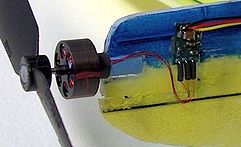
Outrunner
Encyclopedia

This type of motor spins its outer shell around its windings, much like motors found in ordinary CD-ROM
CD-ROM
A CD-ROM is a pre-pressed compact disc that contains data accessible to, but not writable by, a computer for data storage and music playback. The 1985 “Yellow Book” standard developed by Sony and Philips adapted the format to hold any form of binary data....
computer drives. In fact, CD-ROM motors are frequently rewound into brushless outrunner motors for small park flyer
Park flyer
thumb|250px|This [[Grand Wing Servo-Tech]] [[GWS Slow Stick|Slow Stick]] is an example of an indoor/outdoor park flyerThe term park flyer denotes a class of small, primarily electric powered radio controlled aircraft, so named because their size enables some of them to be operated within the...
aircraft. Parts to aid in converting CD-ROM motors to aircraft use are commercially available.
Outrunners spin much slower than their inrunner
Inrunner
The term inrunner refers to a type of brushless motor used in radio controlled models, especially in reference to their use in aircraft to differentiate them from outrunners....
counterparts with their more traditional layout (though still considerably faster than ferrite
Ferrite (magnet)
Ferrites are chemical compounds consisting of ceramic materials with iron oxide as their principal component. Many of them are magnetic materials and they are used to make permanent magnets, ferrite cores for transformers, and in various other applications.Many ferrites are spinels with the...
motors) while producing far more torque
Torque
Torque, moment or moment of force , is the tendency of a force to rotate an object about an axis, fulcrum, or pivot. Just as a force is a push or a pull, a torque can be thought of as a twist....
. This makes an outrunner an excellent choice for directly driving electric aircraft propeller
Propeller
A propeller is a type of fan that transmits power by converting rotational motion into thrust. A pressure difference is produced between the forward and rear surfaces of the airfoil-shaped blade, and a fluid is accelerated behind the blade. Propeller dynamics can be modeled by both Bernoulli's...
s since they eliminate the extra weight, complexity, inefficiency and noise of a gearbox.
Outrunner motors have quickly become popular and are now available in many sizes. They have also become popular in personal, electric transportation applications such as electric bikes and scooters due to their compact size and favorable power-to-weight ratios.
Electromagnetic gearing
The stationary (stator) windings of an outrunner motor are excited by conventional DC brushless motor controllers. A direct current (switched on and off at high frequency for voltage modulation) is typically passed through three or more non-adjacent windings together, and the group so energized is alternated electronically based upon rotor position feedback. The number of permanent magnets in the rotor does not match the number of stator poles, however. The difference between the number of magnet poles and the number of stator poles provides an effect that can be understood as similar to planetary gearing. The number of magnet poles divided by 2 gives the ratio of magnetic field rotation speed to motor rotation speed. Consequently the advance of the electromagnetic impulse around the motor axis proceeds much faster than the rotor turns. With more magnet poles the maximum torque is increased, while the speed of rotor advance is decreased in proportion to the ratio of magnet poles to stator poles.Common Stator pole/Magnetpole configurations:
9N,12P - very common to many small outrunners. This is also the most common CD-ROM motor configuration. Winding Pattern is ABCABCABC
9N, 6P - Common for helicopter motor, EDFs, and other high speed applications. The winding pattern is ABCABCABC
12N, 14P (DLRK) - Common for higher torque applications. Noted commonly for its smooth and quiet operation. Winding Pattern is AabBCcaABbcC (lowercase implies reverse in winding direction).
Other configurations:
9N, 8P - Magnetically imbalanced motor configuration occasionally found in high speed applications. This configuaration is best terminated as WYE to minimize vibration.
9N, 10P - Highly magnetically imbalanced motor that often makes for noisy running. This configuration is usually only built by do it yourself motor builders. This motor is best terminated WYE. Winding pattern is AaABbBCcC
12N, 16P - A not so common but still used style. It has been overshadowed by the 12N, 14P. Winding pattern is ABCABCABCABC
12N, 10P - Higher speed variant of the DLRK motor. Occasionally found in helicopter motors. Winding Pattern is AabBCcaABbcC (lowercase implies reverse in winding direction).
12N, 8P - Even higher speed than the 12N, 10P. Winding pattern is ABCABCABCABC

